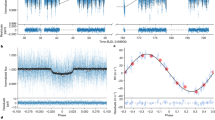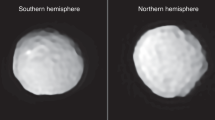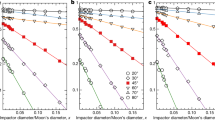Abstract
The orbital properties of Phoebe, one of Saturn's irregular moons, suggest that it was captured by the ringed planet's gravitational field rather than formed in situ. Phoebe's generally dark surface shows evidence of water ice1, but otherwise the surface most closely resembles that of C-type asteroids2 and small outer Solar System bodies such as Chiron and Pholus that are thought to have originated in the Kuiper belt3. A close fly-by of Phoebe by the Cassini–Huygens spacecraft on 11 June 2004 (19 days before the spacecraft entered orbit around Saturn) provided an opportunity to test the hypothesis that this moon did not form in situ during Saturn's formation, but is instead a product of the larger protoplanetary disk or ‘solar nebula’. Here we derive the rock-to-ice ratio of Phoebe using its density4,5 combined with newly measured oxygen and carbon abundances in the solar photosphere6,7. Phoebe's composition is close to that derived for other solar nebula bodies such as Triton and Pluto, but is very different from that of the regular satellites of Saturn, supporting Phoebe's origin as a captured body from the outer Solar System.
This is a preview of subscription content, access via your institution
Access options
Subscribe to this journal
Receive 51 print issues and online access
$199.00 per year
only $3.90 per issue
Buy this article
- Purchase on Springer Link
- Instant access to full article PDF
Prices may be subject to local taxes which are calculated during checkout

Similar content being viewed by others
References
Brown, M. Near-infrared spectroscopy of Centaurs and irregular satellites. Astron. J. 119, 977–983 (2000)
Simonelli, D. P. et al. Phoebe: Albedo map and photometric properties. Icarus 138, 249–258 (1999)
Cruikshank, D. P. et al. The composition of Centaur 5145 Pholus. Icarus 135, 389–407 (1998)
Porco, C. et al. Observations of the Saturn system from the imaging science subsystem on Cassini. Science (in the press)
Jacobson, R. A. et al. The orbits of the major Saturnian satellites and the gravity field of the Saturnian system. Proc. Am. Astron. Soc DPS Meet. 36, 15.02 (2004)
Asplund, M. et al. Line formation in solar granulation. IV. [OI], O I and OH lines and the photospheric O abundance. Astron. Astrophys. 417, 751–768 (2004)
Allende Prieto, C., Lambert, D. L. & Asplund, M. A reappraisal of the solar photospheric C/O ratio. Astrophys. J. 573, L137–L140 (2002)
Jacobson, R. A. The orbits of the major Saturnian satellites and the gravity field of Saturn from spacecraft and Earth-based observations. Astron. J. 128, 492–501 (2004)
Merline, W. J. et al. Discovery of a moon orbiting the asteroid 45 Eugenia. Nature 401, 565–568 (1999)
Clark, R. N. et al. Compositional maps of Saturn's moon Phoebe from imaging spectroscopy. Nature doi:10.1038/nature03558 (this issue)
Stern, S. A., McKinnon, W. B. & Lunine, J. I. in Pluto and Charon (eds Stern, S. A. & Tholen, D. J.) 605–663 (Univ. Arizona Press, Tucson, 1997)
McKinnon, W. B., Lunine, J. I. & Banfield, D. in Neptune and Triton (ed. Cruikshank, D. P.) 807–877 (Univ. Arizona Press, Tucson, 1996)
Prinn, R. G. & Fegley, B. in Origin and Evolution of Planetary and Satellite Atmospheres (eds Atreya, S. K., Pollack, J. B. & Matthews, M. S.) 78–136 (Univ. Arizona Press, Tucson, 1989)
Simonelli, D. P. et al. The carbon budget in the outer solar system. Icarus 82, 1–35 (1989)
Consolmagno, G. J. & Schaeffer, M. Worlds Apart: A Textbook in Planetary Sciences (Prentice-Hall, Englewood Cliffs, 1994)
Fegley, B. Kinetics of gas-grain reactions in the solar nebula. Space Sci. Rev. 92, 177–200 (2000)
Ransford, G. A., Finnerty, A. A. & Collerson, K. D. Europa's petrological thermal history. Nature 289, 21–24 (1981)
Anders, E. & Grevesse, N. Abundances of the elements: Meteoritic and solar. Geochim. Cosmochim. Acta 53, 197–214 (1989)
Prinn, R. G. in Protostars and Planets III (eds Levy, E. H. & Lunine, J. I.) 1005–1028 (Univ. Arizona Press, Tucson, 1993)
Owen, T. C. et al. Surface ices and the atmospheric composition of Pluto. Science 261, 745–748 (1993)
Lodders, K. Solar system abundances and condensation temperatures of the elements. Astrophys. J. 591, 1220–1247 (2003)
Eluszkiewicz, J. Compaction and internal structure of Mimas. Icarus 84, 215–225 (1990)
Mosqueira, I. & Estrada, P. R. Formation of the regular satellites of giant planets in an extended gaseous nebula II: satellite migration and survival. Icarus 163, 232–255 (2003)
Acknowledgements
This study was supported by the Cassini Project. A portion of the work was done at the Jet Propulsion Laboratory, California Institute of Technology, under a contract from NASA.
Author information
Authors and Affiliations
Corresponding author
Ethics declarations
Competing interests
The authors declare that they have no competing financial interests.
Rights and permissions
About this article
Cite this article
Johnson, T., Lunine, J. Saturn's moon Phoebe as a captured body from the outer Solar System. Nature 435, 69–71 (2005). https://doi.org/10.1038/nature03384
Received:
Accepted:
Issue Date:
DOI: https://doi.org/10.1038/nature03384
This article is cited by
-
Experimenting with Mixtures of Water Ice and Dust as Analogues for Icy Planetary Material
Space Science Reviews (2019)
-
Circumplanetary Dust Populations
Space Science Reviews (2019)
-
Water and Volatiles in the Outer Solar System
Space Science Reviews (2017)
-
The origin of the Martian moons revisited
The Astronomy and Astrophysics Review (2011)
-
TNOs are Cool: A Survey of the Transneptunian Region
Earth, Moon, and Planets (2009)
Comments
By submitting a comment you agree to abide by our Terms and Community Guidelines. If you find something abusive or that does not comply with our terms or guidelines please flag it as inappropriate.



